ISSN ONLINE(2278-8875) PRINT (2320-3765)
ISSN ONLINE(2278-8875) PRINT (2320-3765)
Prashant R.T,1 Vani R. M2 and Hunagund P.V3
|
| Related article at Pubmed, Scholar Google |
Visit for more related articles at International Journal of Advanced Research in Electrical, Electronics and Instrumentation Engineering
This paper presents the design and development of rectangular microstrip patch antenna (MSA) with complimentary split ring resonator (CSRR) loaded ground plane. Microstrip patch antenna with complimentary split ring resonator (MSACSRR) is used for the reduction in size and enhanced bandwidth. The technique is based on etching out square CSRR which is from the centre of the metallic ground plane behind the radiating patch of the antenna. The MSACSRR makes its size compact by 10.04% compared to the size of the conventional microstrip antenna designed for the same frequency. Along with the size reduction the bandwidth is also increased to 29.6% when compared to the conventional MSA. The results are experimentally measured and compared with IE3D simulated results. The measured and simulated results are presented and discussed, which are in good agreement with each other. The proposed antenna is suitable for WLAN applications.
Keywords |
| Microstrip patch antenna, CSRR, miniaturization, bandwidth, IE3D. |
I.INTRODUCTION |
| In modern wireless communication systems, the microstrip patch antennas are commonly used in the wireless devices. Therefore, the miniaturization of the patch antenna becomes an important issue in reducing the volume of entire communication system. The common method for reducing the microstrip patch antenna size is to utilize a high permittivity dielectric substrate [1-3]. But, the antennas are more expensive, have less radiation efficiency and narrow bandwidth. To overcome the above drawbacks, many design techniques for the patch antenna have already been proposed. These antennas have the inserted slot, the meandering slots, the corrugation structure, iris structure and the shorting pin. However, all of these design strategies have limitations, which are complex structure and have low performance for miniaturization. So, the design methods of the miniaturized patch antenna with metamaterial technology have been reported by some authors, recently [4]. These would include the SRR or CSRR on the microstrip patch. In other words, the achievement of size reduction of antenna with the SRR and CSRR has special meaning in the field of microstrip antenna [6-7]. In this paper, the miniaturized microstrip patch antenna with CSRRs is presented. |
II. ANTENNA AND CSRR CONFIGURATION |
| Fig. 1 shows the geometry of the proposed conventional MSA, where a low cost glass epoxy FR4 dielectric material with relative permittivity (εr) of 4.4 with thickness (h) of 1.6mm is chosen. The conventional MSA is designed for 6GHz with dimensions L and W radiating part, which is excited by simple 50 Ω microstrip feed having dimensions length Lf and width Wf using quarter wave length transformer of dimension length Lt and Wt for their impedance matching. The length Lg and Wg of the ground plane of the antenna is calculated by Lg=6h+L and Wg=6h+ W and all the dimensions are shown in table 1. |
| The study is carried by etching square CSRR in the ground plane as shown in Fig 1 (b). Initially the slot length is varied from 3.2mm to 6.2mm in steps of 1mm. In the antenna MSACSRR-1with SL =3.2mm, MSACSRR-2 with SL =4.2mm, MSACSR-3 with SL = 5.2mm and finally MSACSRR-4 with SL = 6.2mm is considered. By varying the SL the antenna resonating frequency is shifted towards left and the size of the antenna is virtually reduced. So, the final optimized slot length SL=6.2mm is taken by keeping all other parameters of the CSRR constant and it is MSACSRR-4 which is shown in table 2. Fig. 2 (a) & (b) shows the photographic view of proposed microstrip antenna and MSACSRR-4 respectively. Fig. 3 shows the enlarged geometry of CSRR with dimensions. |
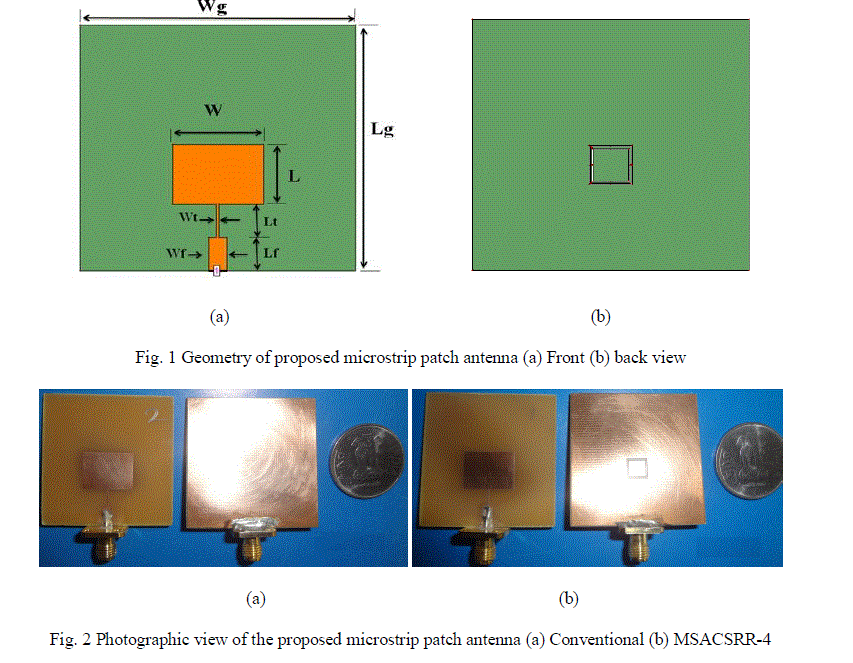 |
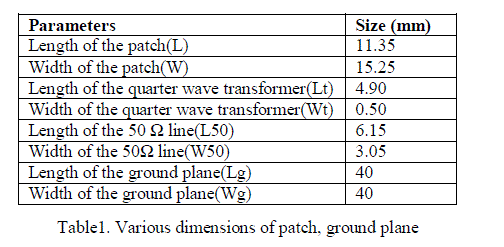 |
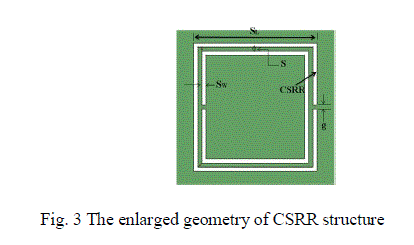 |
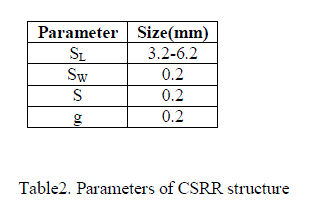 |
III. RESULTS AND DISCUSSIONS |
| The simulation is carried out by using the mentor graphics IE3D simulation software version 14.65 [5]. The parameters of the proposed antennas are measured on Vector Network Analyzer (VNA) (Rhode and Schwarz, Germany make ZVK model 1127.8651). |
| Fig. 4 shows the simulated return loss characteristics of conventional MSA and MSACSRR-1, MSACSRR-2, MSACSRR-3 and MSACSRR-4. From this figure it is seen that, conventional MSA resonates at 5.91GHz and the optimized MSACSRR-4 is resonating at 5.32GHz. The impedance bandwidth over return loss less than -10dB is determined by using the equation |
 |
| Where, f1 and f2 are the lower and upper cut-off frequencies of the band respectively, when its return loss reaches -10dB and fC is the centre frequency between f1 and f2. All the simulated results of antennas are shown in table 3. |
| In the next step the optimized antenna MSACSRR-4 is practically fabricated and antenna parameters are measured experimentally with Vector Network Analyser and the results are shown in Table 4. Fig. 5 shows the simulated and measured return loss characteristics of conventional MSA. Fig. 6 shows the simulated and measured return loss characteristics of the optimized antenna MSACSRR-4. It is observed from the figure that, the simulated value is at 5.32GHz, where as the practically measured value is at 5.46GHz with a bandwidth of 255MHz and 250MHz respectively. Both the simulated and measured results are in good agreement with each other. |
| Fig. 7(a) and Fig. 7(b) show the radiation patterns of conventional MSA and MSACSRR-4 at their operating bands. From these figures it is seen that, the patterns are broadside in nature in both the cases. |
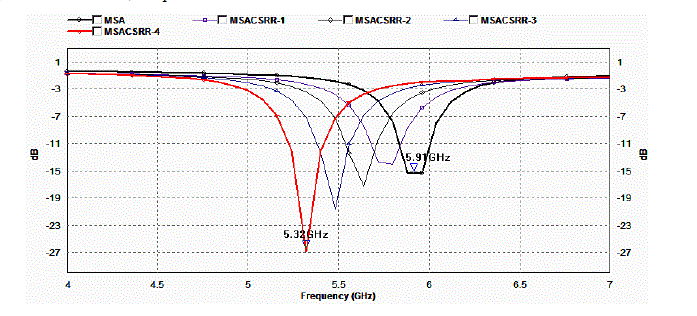 |
| Fig. 4 Simulated return loss characteristics of proposed antennas with and without CSRR |
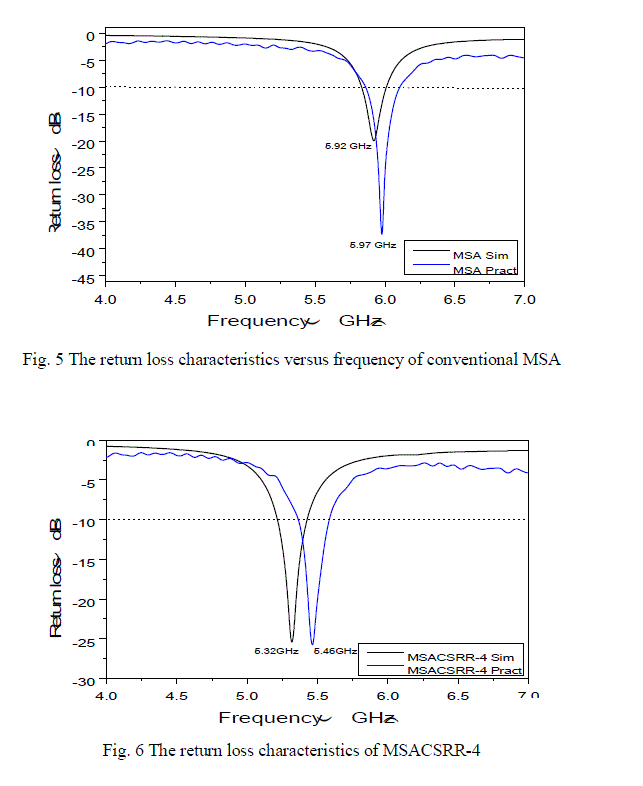 |
 |
 |
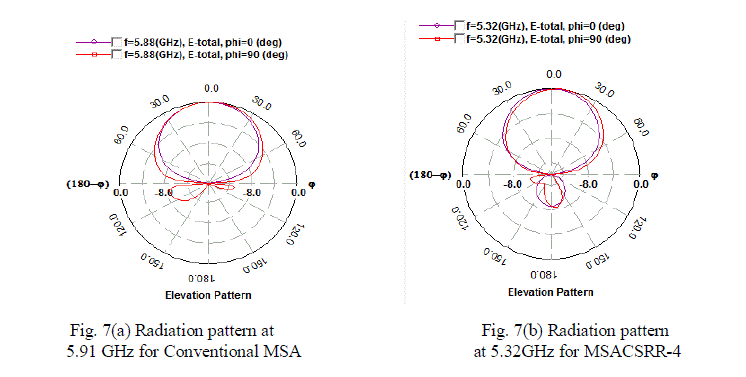 |
IV. CONCLUSIONS |
| A compact microstrip antenna with improved bandwidth using a CSRR design based on metamaterial technique has been presented. The proposed design helps to achieve both reduction in the antenna size and the improvement in the bandwidth. The results presented in this paper are promising design of compact antennas without having to sacrifice the antenna bandwidth, which makes the antenna useful for wireless applications. |
ACKNOWLEDGEMENT |
| The authors acknowledge their thanks to UGC, New Delhi for sanctioning the IE3D software under Major Research Project, which is most useful and reliable for designing microstrip antennas and DST, New Delhi for sanctioning Vector Network Analyzer for measuring the parameters of fabricated antenna. |
References |
|